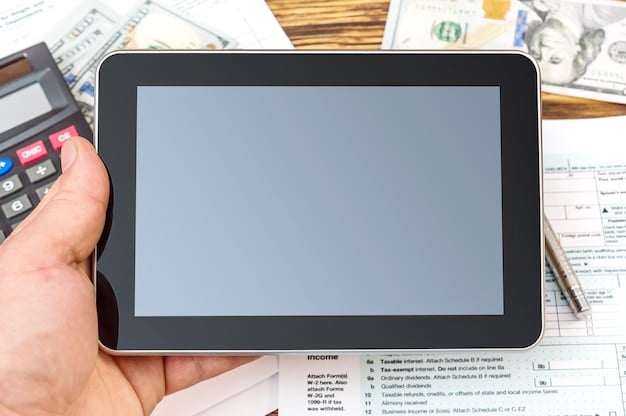Master Your Money: Fix 5 Budgeting Mistakes by 2026

Effective budgeting is a cornerstone of financial stability, but common missteps can derail even the most well-intentioned plans; understanding and rectifying these five prevalent budgeting errors before 2026 is crucial for securing a robust financial future.
As we approach 2026, many of us are setting new financial goals, aiming for greater stability, significant savings, or a complete overhaul of our spending habits. Yet, the journey to financial well-being is often fraught with common pitfalls. This article delves into 5 Common Budgeting Mistakes and How to Fix Them Before 2026, offering actionable strategies to transform your financial landscape.
Underestimating or Ignoring Small Expenses
It’s a familiar scenario: you track the big bills – rent, mortgage, car payments – but the daily lattes, occasional impulse buys, or subscriptions you hardly use slip through the cracks. Individually, these seem insignificant, yet cumulatively, they can siphon off a surprising amount of your hard-earned money each month. This underestimation is a significant flaw in many budgeting attempts, creating a false sense of security about where your money is actually going.
Many people fall into the trap of focusing solely on fixed, large expenses, neglecting the cumulative impact of smaller, variable outlays. This oversight can lead to a budget deficit without clear indicators, as the “miscellaneous” category quietly grows larger than anticipated. Building awareness around these micro-transactions is the first step towards rectifying this common error and gaining a truly holistic view of your financial outflows.
Tracking Every Dollar: The Power of Granularity
To combat this, comprehensive tracking is essential. Modern personal finance apps and spreadsheets make this easier than ever. The goal isn’t to become obsessively frugal but to understand your spending patterns truly. Once you see where every dollar goes, you can make informed decisions rather than guessing.
- Digital Tracking Apps: Use apps like Mint, YNAB (You Need a Budget), or Personal Capital that link to your bank accounts and credit cards, categorizing transactions automatically.
- Manual Tracking: For a more hands-on approach, maintain a simple spreadsheet or even a small notebook, logging every expense, no matter how small. This method can enhance awareness.
- Review Bank Statements: Regularly
review your bank and credit card statements
to identify recurring small charges, especially subscriptions you may have forgotten about.
Implementing the “Catch-All” Category Wisely
While tracking everything is crucial, it’s also practical to allocate a small “miscellaneous” or “fun money” category. The key is to manage this category intentionally, ensuring it doesn’t become a black hole for untracked spending. This allows for flexibility without undermining your overall budget.
The critical insight here is that small expenses are not inherently bad; rather, ignoring them is the problem. By consciously accounting for them, you turn potentially budget-busting habits into manageable, acknowledged parts of your financial plan. This approach transforms invisible drains into visible opportunities for adjustment and allows for genuine financial control, making your budget more realistic and sustainable in the long run.
Setting Unrealistic Budget Goals
Perhaps one of the most common reasons budgets fail is setting goals that are simply unachievable. This often stems from an initial burst of enthusiasm, leading to aggressive savings targets or drastic cuts in spending categories that are integral to one’s lifestyle. While admirable in intent, such extreme measures rarely stick beyond a few weeks or months, leading to frustration and the eventual abandonment of the budget altogether. It’s like embarking on a crash diet; unsustainable efforts often result in a rebound effect.
An unrealistic budget often ignores human nature and real-world costs. If you budget $50 for groceries when your family realistically spends $150, or allot nothing for entertainment when you enjoy going out, failure is almost predetermined. This mismatch between aspiration and reality creates a cycle of guilt and discouragement, making it harder to re-engage with financial planning.
The Importance of a Reality Check
Before even starting to allocate funds, take an honest look at your current spending habits. Analyze your bank statements from the past three to six months. Where does your money *actually* go? This data-driven approach provides a foundation for realistic goal-setting, ensuring your budget aligns with your real financial behavior rather than an idealized version of it.
After the initial assessment, project future expenses and income using a realistic lens. Consider upcoming life events, potential income changes, and how your spending might fluctuate seasonally. The goal is to build a budget that works *for* you, not one that constantly works *against* your natural tendencies.
Employing the 50/30/20 Rule as a Guideline
A popular and flexible framework for general budgeting is the 50/30/20 rule, which suggests allocating:
- 50% of income to Needs: Essential expenses like housing, utilities, groceries, transportation, and health insurance.
- 30% of income to Wants: Discretionary spending such as dining out, entertainment, hobbies, and shopping.
- 20% of income to Savings & Debt Repayment: Contributions to an emergency fund, retirement accounts, or paying down high-interest debt beyond minimums.
This rule isn’t rigid but offers a balanced starting point. Adapt the percentages to fit your unique circumstances. For instance, if you live in a high cost-of-living area, your “needs” might exceed 50%, requiring adjustments elsewhere. The principle is to ensure that, on a broad level, your allocations are sustainable and reflective of your income and obligations. A realistic budget fosters consistency and ultimately leads to more sustainable financial growth, preventing the common trap of aiming too high and falling flat.

Failing to Track Progress Regularly
Creating a budget is an excellent first step, but it’s merely a snapshot. Without consistent monitoring and adjustments, even the most meticulously planned budget can quickly become obsolete or ineffective. Many people meticulously set up their budget at the beginning of the month or year, only to file it away and forget about it until they realize they’ve overspent. This lack of ongoing engagement is a critical error, as a budget is a living document that requires regular attention to remain relevant and useful.
Think of your budget as a financial roadmap. You wouldn’t plan a long journey, then never check the map or your progress. Similarly, your budget needs constant checks to ensure you’re still heading in the right financial direction. Life changes, unexpected expenses arise, and income fluctuates – all of these factors necessitate a dynamic approach to budgeting.
Establishing a Review Routine
The key to fixing this mistake is to build a habit of regular budget review. This doesn’t mean poring over every single transaction daily, but rather setting aside dedicated time to assess your financial health.
- Weekly Check-ins: Dedicate 15-30 minutes each week to review your spending and upcoming bills. Are you on track with your categories? Have any unexpected expenses popped up? This allows for minor adjustments before issues escalate.
- Monthly Deep Dive: At the end of each month, conduct a more thorough review. Compare your actual spending against your budget for all categories. Identify areas where you consistently overspent or underspent. This is also a good time to adjust category allocations for the next month based on insights gained.
- Quarterly or Annual Review: Consider broader financial goals and long-term plans. Are your savings goals still appropriate? Do you need to adjust for inflation or changing life circumstances (e.g., a new job, a new baby, a planned major purchase)?
Using Data to Your Advantage
Regular tracking isn’t just about spotting overspending; it’s about gathering valuable data. When you consistently see that you’re exceeding your grocery budget, it might indicate that your initial allocation was too low, or that you need to find ways to reduce costs. Conversely, if you repeatedly underspend in a certain category, you might reallocate those funds to more pressing goals, like debt repayment or increased savings.
This iterative process of tracking, reviewing, and adjusting makes your budget a powerful tool for financial empowerment, rather than a static constraint. It helps you recognize patterns, celebrate successes, and learn from mistakes, ensuring your financial plan remains a realistic and effective guide towards your monetary objectives. Neglecting this crucial step means missing out on valuable feedback that can significantly improve your financial decision-making over time.
Not Having an Emergency Fund
Life is unpredictable. Despite our best efforts to budget and plan, unexpected expenses—a sudden job loss, a medical emergency, car repairs, or even a leaky roof—can strike at any time. Without a dedicated emergency fund, these unforeseen events can quickly derail even the most robust financial plans, leading to debt, stress, and a significant setback to your financial goals. Neglecting to build or adequately fund an emergency reserve is a critical budgeting mistake that leaves you vulnerable to the whims of fate.
Many people prioritize other financial goals, such as investing or paying down non-emergency debt, over establishing an emergency fund. While these goals are important, they often come with more risk if there’s no safety net underneath. An emergency fund acts as your personal financial shock absorber, protecting you from having to tap into retirement savings, take out high-interest loans, or use credit cards when unexpected costs arise.
Building Your Financial Safety Net
The conventional wisdom suggests having at least three to six months’ worth of essential living expenses saved in an easily accessible, liquid account. For some, especially those with fluctuating incomes or dependents, building a larger fund (e.g., 9-12 months) might be more prudent.
- Start Small: If building a large fund seems daunting, start with a smaller, more achievable goal, like $1,000. This initial “starter” emergency fund can cover many minor emergencies and provide a confidence boost.
- Automate Savings: Set up an automatic transfer from your checking account to a separate savings account specifically designated for emergencies each payday. Treating it like a non-negotiable bill makes it easier to consistently contribute.
- Cut Non-Essentials Temporarily: If you’re struggling to fund your emergency savings, consider temporarily cutting back on non-essential spending (dining out, entertainment, subscriptions) until you reach your initial emergency fund goal.
Where to Keep Your Emergency Fund
The ideal location for your emergency fund is a high-yield savings account separate from your primary checking account. This keeps the money easily accessible in an emergency but out of sight and out of mind for everyday spending.
A high-yield savings account also allows your money to earn a little interest, often offsetting some of the impacts of inflation. Avoid investing your emergency fund in the stock market or other volatile assets, as you need the principal to be secure and readily available when you need it most. Prioritizing the establishment of this fund is not just a defensive financial move; it creates peace of mind and resilience, forming a crucial buffer against life’s inevitable surprises.

Not Budgeting for Irregular or Annual Expenses
One of the common pitfalls in budgeting is overlooking expenses that don’t occur monthly but are predictable. These can range from annual insurance premiums, vehicle registration fees, holiday gifts, or even less frequent expenses like home maintenance or appliance replacements. If these irregular costs aren’t factored into your monthly budget, they can cause significant disruptions when they inevitably arise, leading to frantic scrambling, dipping into savings, or accumulating debt. This oversight often stems from a focus solely on the immediate, recurring bills.
Failing to plan for these expenditures can create a perception that your budget isn’t working, even if you are diligently managing your regular monthly costs. Unexpected “big” bills can quickly deplete an emergency fund meant for true emergencies or force you to cut back drastically on other essential spending, undermining your financial progress and adding unnecessary stress.
Identifying and Listing Irregular Expenses
The first step is to identify all foreseeable non-monthly expenses for the coming year. Look at past bank statements and credit card bills, and think ahead to upcoming events or needs.
- Annual Fees: Car registration, property taxes (if not escrowed), professional licenses, subscription renewals, association fees.
- Seasonal/Holiday Spending: Holiday gifts, summer vacation costs, back-to-school supplies.
- Planned Maintenance/Replacements: Car maintenance, home repairs (e.g., furnace filter replacement, gutter cleaning), technology upgrades.
- Medical/Dental Costs: Anticipated co-pays, deductibles, or out-of-pocket expenses for scheduled appointments or treatments.
The Sinking Fund Strategy
Once you have a comprehensive list, divide the total annual cost of each irregular expense by 12 (or the number of months until it’s due). This gives you the amount you need to set aside each month into a dedicated “sinking fund.”
For example, if your annual car insurance premium is $1,200, setting aside $100 each month ensures you have the full amount ready when the bill is due. Similarly, for holiday gifts, if you estimate spending $600, putting away $50 a month ensures you’re prepared.
Consider creating separate savings accounts or digital envelopes within your banking app for each major sinking fund (e.g., “Car Maintenance Fund,” “Holiday Fund”). This visual separation can help you stay organized and prevent you from accidentally spending money earmarked for a specific future expense. By proactively budgeting for these irregular costs, you eliminate financial surprises and maintain steady progress toward your overall financial objectives. This strategy transforms potential budget crises into manageable, anticipated financial events.
Ignoring Debt Repayment Strategies
One of the most insidious budgeting mistakes is to treat debt repayment merely as paying the minimum due. While meeting minimum payments keeps your accounts in good standing, it often means you’re barely touching the principal, especially with high-interest debts like credit cards. This approach traps you in a cycle of high interest charges, extends the life of your debt for years, and significantly delays your ability to achieve other financial goals, such as saving for a down payment or retirement. Many people pay lip service to debt repayment without truly crafting an aggressive strategy to tackle it.
Ignoring a deliberate debt repayment strategy means that a significant portion of your income is constantly being diverted to interest, rather than building your own wealth. This can feel like running on a financial treadmill, making progress feel elusive even when you’re diligently managing other parts of your budget.
Prioritizing High-Interest Debt: The Debt Avalanche Method
One of the most financially efficient ways to tackle debt is the debt avalanche method. This strategy involves ranking all your debts by interest rate, from highest to lowest. You continue to make minimum payments on all debts, but any extra money you have available in your budget is exclusively directed towards the debt with the highest interest rate.
Once the highest-interest debt is paid off, you take the money you were paying on that debt (both the minimum payment and the extra amount) and apply it to the next highest-interest debt. This creates a snowball effect of increasingly larger payments, allowing you to pay off debt faster and save a significant amount on interest charges over time. This method is mathematically optimal as it reduces the total interest paid.
Building Momentum: The Debt Snowball Method
For those who need psychological wins to stay motivated, the debt snowball method can be highly effective. With this strategy, you list your debts from the smallest balance to the largest, regardless of the interest rate.
Similar to the avalanche method, you make minimum payments on all debts, but direct any extra funds in your budget to the debt with the smallest balance. Once that smallest debt is paid off, you take the money you were paying on it and apply it to the next smallest debt. While not as mathematically efficient, the rapid succession of paying off smaller debts can provide powerful motivation and build momentum, making it easier to stick with your debt repayment journey.
Both methods offer structured approaches to debt repayment beyond just minimum payments. Integrating either of these strategies into your budget transforms debt reduction from a passive obligation into an active, empowering financial goal. By focusing intentionally on accelerated debt repayment, you free up cash flow, reduce financial stress, and unlock greater potential for future savings and investments, pushing you closer to true financial freedom before 2026.
| Key Mistake | Brief Fix |
|---|---|
| 💸 Underestimating Small Expenses | Track every dollar, no matter how small, using apps or manual logs for a holistic view. |
| 🎯 Unrealistic Budget Goals | Base your budget on past spending and use flexible guidelines like the 50/30/20 rule. |
| 🔄 Failing to Track Progress | Implement weekly/monthly check-ins to review spending and make necessary adjustments. |
| 🛡️ No Emergency Fund | Build 3-6 months of expenses in a dedicated high-yield savings account as a safety net. |
Frequently Asked Questions About Budgeting
▼
Tracking small expenses is vital because these seemingly insignificant costs accumulate rapidly, forming a significant portion of overall spending. Ignoring them leads to an inaccurate financial picture, making it challenging to understand true cash flow and identify areas for savings. It fosters financial awareness and prevents budget leaks that can undermine larger financial goals.
▼
To set realistic budget goals, start by reviewing your past 3-6 months of spending to understand your actual habits. Avoid drastic cuts that are unsustainable. Use flexible frameworks like the 50/30/20 rule as a guideline, adjusting percentages to fit your unique income and essential expenses. Incremental adjustments are more effective than overnight overhauls for long-term adherence.
▼
The best way to track your budget regularly is to establish a consistent review routine. This could involve weekly 15-minute check-ins and a more comprehensive monthly review. Utilize budgeting apps that link to your accounts for automated tracking, or maintain a detailed spreadsheet for manual input. Consistency ensures you catch deviations early and can make timely adjustments, keeping your budget dynamic.
▼
An emergency fund is crucial because it acts as a financial safety net against unexpected life events like job loss, medical emergencies, or unforeseen home repairs. Without it, such events often lead to accumulating high-interest debt or liquidating long-term investments. It provides financial security and peace of mind, protecting your budget from being completely derailed by surprises.
▼
Effectively manage irregular annual expenses by creating “sinking funds.” First, list all anticipated non-monthly costs (e.g., annual insurance, holiday gifts). Then, divide the total annual amount for each by 12 and set aside that portion monthly into a dedicated savings account or digital envelope. This proactive approach ensures funds are available when needed, preventing financial surprises.
Conclusion
Mastering your budget is not about restrictive deprivation; it’s about achieving clarity, control, and confidence in your financial life. By identifying and proactively addressing these five common budgeting mistakes—underestimating small expenses, setting unrealistic goals, neglecting regular tracking, failing to build an emergency fund, and ignoring strategic debt repayment—you can significantly enhance your financial well-being. The journey to financial mastery is iterative, requiring consistent effort and a willingness to adapt. As we look towards 2026, implementing these fixes will not only help you avoid common pitfalls but also pave the way for a more secure and prosperous future. Take these insights, apply them with diligence, and empower yourself to build a budget that truly works for you, transforming mere intentions into impactful financial realities.





